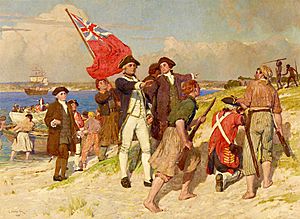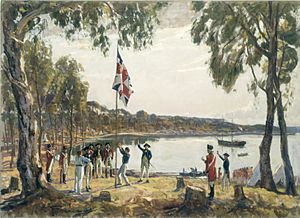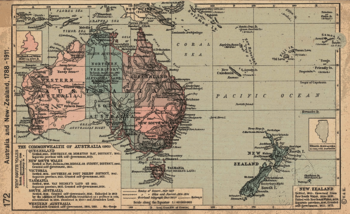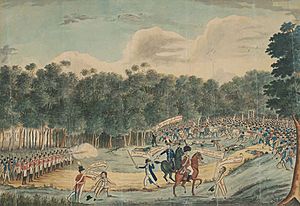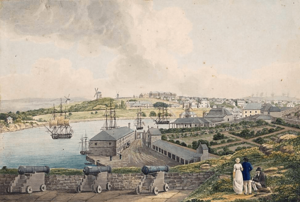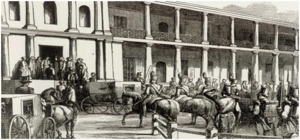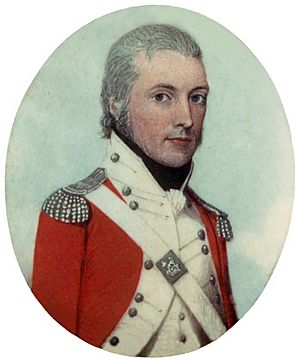History of Australia (1788–1850) facts for kids
The early history of Australia (1788 to 1850) is about the first British settlements. It began in 1788 when the First Fleet of British ships arrived at Port Jackson. This area, known as Warrane by the local Eora people, became the penal colony of New South Wales. A penal colony was a place where criminals were sent as punishment. This period also saw Europeans exploring the continent and setting up other colonies that became Australia's modern states.
After some tough years, the colony slowly grew. Its economy was based on farming, fishing, whaling, trade, and building with the help of convict workers. By 1820, British settlements were mostly around Sydney and in Van Diemen's Land (now Tasmania). More convicts were sent to Australia after 1816, and the number of free settlers also grew.
Van Diemen's Land became a separate colony in 1825. New free settlements were started in Western Australia (1829), South Australia (1836), and the Port Phillip District (1836), which later became Victoria. As cattle and sheep farming spread inland, there were more conflicts with Aboriginal people on their traditional lands.
More free settlers, former convicts, and Australian-born people called "currency lads and lasses" wanted a say in their government. Sending convicts to New South Wales stopped in 1840. A council with some elected members was set up in 1842. In 1850, Britain gave Van Diemen's Land, South Australia, and the new colony of Victoria their own councils with some elected members.
British settlement caused a big drop in the Aboriginal population. New diseases, violent conflicts, and losing their traditional lands harmed their cultures. Aboriginal people often fought back against the British taking their land. This sometimes led to massacres of Aboriginal people by settlers. However, many Aboriginal people tried to live peacefully with the settlers. They created communities, often on small parts of their traditional lands, and kept many parts of their cultures alive.
Contents
The Start of British Settlement
The British decided to start a colony in Australia for two main reasons. First, they could no longer send criminals to North America after the American Revolution. Second, they needed a base in the Pacific Ocean to stop France from expanding its power there. Over 150 years, about 50,000 convicts were sent to Australia. The First Fleet was a huge project for the British navy. It was also the first time so many settlers were forced to move to a new colony.
Sir Joseph Banks, a famous scientist who sailed with Lieutenant James Cook in 1770, suggested Botany Bay as a good spot. The local Gweagal people knew this area as Kamay. A plan was made to settle the area, and it later included convicts.
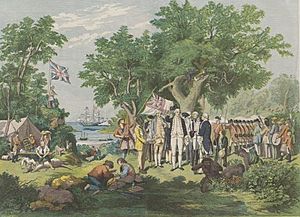
On May 13, 1787, the First Fleet set sail for Botany Bay. It had 11 ships and about 1,530 people. This included 736 convicts, their children, marines, and officers. Captain Arthur Phillip led the fleet.
After arriving at Botany Bay, the fleet moved to the better Port Jackson. A settlement was started at Sydney Cove on January 26, 1788. This date is now Australia Day. Governor Phillip formally claimed the colony on February 7, 1788. Sydney Cove had fresh water and a safe harbour. Phillip called it "the finest Harbour in the World."
Phillip named the settlement after Thomas Townshend, 1st Viscount Sydney, the Home Secretary. A few days before the British arrived, a French expedition led by Admiral Jean-François de Galaup, comte de La Pérouse also reached Botany Bay. The French were friendly but showed that France was also interested in the new land.
Governor Phillip had complete power over the colony's people. He wanted to have good relations with the local Aboriginal people. He also aimed to reform and discipline the convicts. The first years were very hard. Food was scarce, and many convicts were sick or not skilled for farming. The food crisis was very bad in 1790. However, after 1791, more ships arrived regularly, bringing supplies and making the colony feel less isolated.
In 1792, two French ships, La Recherche and L'Espérance, anchored near Tasmania. This was when Britain and France were racing to explore and claim Australia. The French expedition had scientists, mapmakers, and artists. They studied and recorded the environment and people they met.
The first white settlers were English convicts, guarded by Royal Marines. Many marines later stayed in the colony as settlers. They faced challenges, and the name "Botany Bay" became a term of shame for anyone from New South Wales.
Convicts and Free Settlers
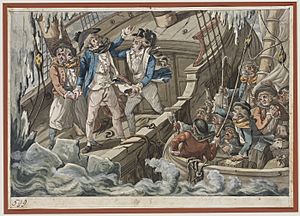
The first free settlers arrived in Sydney Cove on January 16, 1793. They were given free passage, farm tools, two years' food, and land. They also received help from convicts, who were given food and clothing. Their land was called "Liberty Plains," located west of Sydney. This area is now the suburbs of Strathfield and Homebush.
About one in three convicts sent after 1798 were Irish. Many were sent for political reasons or for causing trouble in Ireland. Few of the first convicts or soldiers had farming skills. They also did not understand Australia's seasons. This led to early farming failures, and the colony almost starved. Governor Phillip had to send a ship to Batavia (Jakarta) for supplies. Life was very difficult for the first few years.
The Second Fleet in 1790 brought two important men to Sydney. One was D'Arcy Wentworth, whose son, William Charles, became an explorer and started Australia's first newspaper. He also led the movement to end convict transportation. The other was John Macarthur, a Scottish army officer. He started the Australian wool industry, which became very important for Australia's wealth. Macarthur was involved in the Rum Rebellion in 1808 against Governor William Bligh.
Convicts were usually sentenced to seven or fourteen years of hard labour, or for life. Often, these sentences were changed from the death penalty. When they arrived, convicts were given different jobs. Skilled workers like stonemasons were in high demand. Unskilled convicts worked in gangs to build roads. Female convicts usually worked as domestic servants for free settlers.
Convicts were often assigned to free settlers. The settlers were responsible for feeding and disciplining them. In return, the settlers received land. This system helped reduce the government's workload. Convicts not assigned to settlers lived in barracks, like the Hyde Park Barracks.
Convict discipline was strict. Those who refused to work or disobeyed orders were punished, often by flogging. Some were put in chains or sent to stricter penal colonies. Port Arthur in Tasmania and Moreton Bay in Queensland were stricter than Sydney. Norfolk Island was the strictest of all.
Convicts who behaved well could get a "ticket of leave." This gave them some freedom. Those who finished their sentences or were pardoned often stayed in Australia as free settlers. They could even have convicts working for them.
In 1789, a former convict named James Ruse grew the first successful wheat crop in New South Wales. Governor Phillip rewarded him with the first land grant in the colony. Ruse's farm, called 'Experiment Farm,' near Parramatta, was the colony's first successful farm. More farmers followed, and the colony began to grow enough food for itself. Life slowly got better for the residents.
In 1804, about 200 escaped Irish convicts led the Castle Hill convict rebellion. The New South Wales Corps quickly stopped it. On January 26, 1808, there was a military rebellion against Governor William Bligh, led by John Macarthur. After this, Governor Lachlan Macquarie arrived in 1810. He was told to restore order. He sent the New South Wales Corps away and brought in a new regiment.
Growth of Free Settlement
From about 1815, under Governor Lachlan Macquarie, the colony grew quickly. More free settlers arrived, and new lands were opened for farming. Despite the long sea journey, settlers were drawn by the chance to start a new life on almost free land. From the late 1820s, settlement was only allowed in specific areas called the Nineteen Counties.
Many settlers, known as "squatters," took land without permission beyond these limits. They became a powerful group of landowners. Because of opposition from workers, sending convicts to Sydney ended in 1840. However, it continued in smaller colonies like Van Diemen's Land (Tasmania) and Moreton Bay (Queensland) for a few more years.
The Swan River Colony (Western Australia), centered in Perth, was founded in 1829. This colony always needed more workers. By 1850, local business owners convinced London to send convicts there. Convict transportation to Australia finally ended in 1868. New Zealand was part of New South Wales until 1840, when it became a separate colony.
Key Dates
- May 13, 1787 – The 11 ships of the First Fleet leave Portsmouth, England. They carry about 1,350 people, including 780 convicts.
- January 18, 1788 – The First Fleet arrives in Botany Bay. They soon move to Port Jackson, landing in Sydney Cove on January 26, 1788.
- 1788 – New South Wales is declared. It includes all islands in the Pacific Ocean and extends west to the 135th meridian east. This includes New Zealand.
- April 1789 – A smallpox outbreak greatly reduces the local Aboriginal population.
- 1790 – The Second Fleet of convicts arrives in Sydney Cove.
- 1793 – January: The first free settlers arrive in New South Wales.
- 1824 – May: Brisbane is founded.
- June 14, 1825 – The colony of Van Diemen's Land becomes separate. Its name officially changes to Tasmania on January 1, 1856. The first settlement was at Risdon, Tasmania in 1803. A successful settlement was later made at nipaluna (Hobart) in 1804.
- 1825 – New South Wales's western border is moved to 129° E.
- January 21, 1827 – Western Australia is created. A small British settlement is started at King George's Sound (Albany). The new Swan River Colony is officially declared on June 18, 1829.
- 1835 – The Proclamation of Governor Bourke states that Australia was considered empty land when the British arrived. This meant British subjects could not buy land directly from Aboriginal Australians.
- December 28, 1836 – The British province of South Australia is established. It was never a British convict colony.
- 1841 – New Zealand becomes a separate colony from New South Wales.
European Exploration
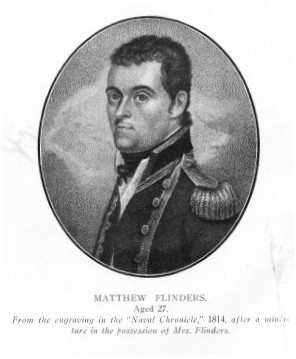
European exploration in Australia began before the First Fleet. William Dampier explored in 1699. Lieutenant James Cook mapped the entire east coast in 1770. In 1795, George Bass and Matthew Flinders explored the Georges River near Sydney. Their reports led to the settlement of Bankstown. In 1798–99, Bass and Flinders sailed around Van Diemen's Land, proving it was an island.
Aboriginal guides often helped European explorers. In 1801–02, Matthew Flinders led the first trip around Australia. The Aboriginal explorer Bungaree was with him. Bungaree was the first person born in Australia to sail around the continent.
In 1813, Gregory Blaxland, William Lawson, and William Wentworth crossed the Blue Mountains west of Sydney. They found vast grasslands, which allowed British settlement to expand inland.
By 1820, British settlement was mostly within 100 kilometers of Sydney and in central Van Diemen's Land. The settler population was 26,000 on the mainland and 6,000 in Van Diemen's Land.
In 1824, Governor Sir Thomas Brisbane asked Hamilton Hume and William Hovell to find new grazing land in the south. They also wanted to find out where New South Wales's western rivers flowed. In 1824–25, Hume and Hovell traveled to Port Phillip Bay. They found important places like the Murray River and good farming lands.
Charles Sturt explored the Macquarie River in 1828 and found the Darling River. People thought the inland rivers flowed into an inland sea. In 1829, Sturt followed the Murrumbidgee River into the Murray River. He followed it to where it met the sea in South Australia. His party then had to row back upstream.
Surveyor General Sir Thomas Mitchell led expeditions from the 1830s to fill in the map. He carefully recorded original Aboriginal place names. That is why many places still have their Aboriginal names today.
The Polish explorer Count Paul Edmund Strzelecki surveyed the Australian Alps in 1839. He was the first European to climb Australia's highest peak. He named it Mount Kosciuszko after a Polish hero.
Aboriginal Resistance and Adaptation
Aboriginal people reacted in different ways to the British settlers. Often, they were hostile when the colonists took their land and resources. Diseases brought by the settlers greatly reduced Aboriginal populations. Losing land and food sources sometimes led to starvation. Unlike New Zealand, no formal treaties were signed with Aboriginal peoples in Australia.
Aboriginal men like Pemulwuy and Yagan fought against British settlement in the late 1700s and early 1800s. In Tasmania, a conflict known as the "Black War" happened in the first half of the 1800s.
Support and Protection Efforts
In the first two years, Aboriginal people in Sydney mostly avoided the newcomers. In 1790, after a smallpox epidemic, Bennelong led survivors into Sydney. Bungaree helped Matthew Flinders on his trip around Australia, acting as a go-between with different Indigenous groups.
In 1815, Governor Macquarie set up a Native Institution to educate Aboriginal children. He also gave land to 15 Aboriginal families near Sydney. In 1816, he started an annual Native Feast. However, by the 1820s, these efforts had mostly failed. Aboriginal people continued to live on the edges of Sydney, adapting their traditions to the new environment.
As conflicts grew in the 1820s and 1830s, colonial governments tried to protect Aboriginal people. "Protectors of Aborigines" were appointed in South Australia and the Port Phillip District in 1839. While the goal was to give Aboriginal people the protection of British law, it often led to more arrests. Protectors also gave out food, taught children, and offered Christian instruction. But by 1857, these offices closed because they were costly and did not meet their goals.
Governments also set up a few reserves and encouraged Christian missions. These offered some protection from violence. In 1825, a large area was granted for an Aboriginal mission at Lake Macquarie. Missions also existed in other areas in the 1830s and 1840s.
In more settled areas, most Aboriginal people who lost their land lived on reserves, missions, or near towns. In farming areas, a British law in 1848 gave traditional landowners limited rights to live and hunt on Crown land used for grazing. Many Aboriginal groups camped on farms, where Aboriginal men often worked as shepherds. These groups could keep a connection to their lands and maintain parts of their traditional culture.
Politics and Government
Traditional Aboriginal society was led by elders and group decisions. But the first European governments after 1788 were run by appointed governors. These governors were directly in charge. However, English law, including ideas from the Magna Carta, was brought to Australia.
From 1788 to the 1850s, governors made most decisions and reported to the government in London. The first governor, Arthur Phillip, had wide powers. He could set up courts, military forces, give out land, and control the economy.
Early colonists adopted British political customs. This meant public office was sometimes used for private gain. Officers of the New South Wales Corps tried to control trade. Governor Francis Grose encouraged this by giving land and convict workers to officers. The Corps gained a monopoly on the rum trade and became very powerful. Governor William Bligh tried to stop their control. This led to the Rum Rebellion in 1808, where officers led a takeover. The British government later disbanded the Corps.
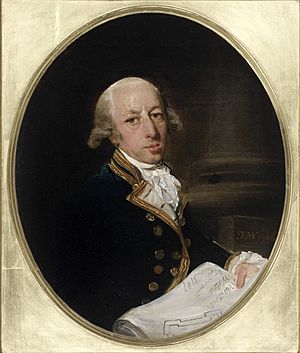
The New South Wales Act 1823 created Australia's first law-making body, the New South Wales Legislative Council. It had five to seven appointed members who advised the Governor. This council had limited power. The Act also set up the Supreme Court of New South Wales, which could check the Governor's decisions.
Newspapers like The Australian (1824) and The Sydney Morning Herald (1831) began publishing. Governor Ralph Darling tried to control the press.
Van Diemen's Land became a separate colony in 1825. Western Australia was claimed by James Stirling, and the Swan River Colony was established in 1829. The South Australian Company was formed in 1834 to create a new colony. It was based on ideas of social reform.
Political Groups
British political differences, like liberal versus conservative, also appeared in Australia. There was also a divide between "emancipists" (former convicts) and "exclusivists" (free settlers who owned land). Conservatives worried that former convicts would vote against their interests. John Macarthur, a wool producer, was a conservative leader. They believed they were guiding the colony's economic growth.
William Wentworth started the Australian Patriotic Association in 1835. This was Australia's first political party. It demanded democratic government for New South Wales. The Attorney General, John Plunkett, worked to make everyone equal before the law. He extended jury rights to former convicts and legal protections to convicts and Aboriginal peoples.
Representative Government
In 1840, the Adelaide City Council and the Sydney City Council were created. Men with a lot of property could run for election. Wealthy landowners could have up to four votes. Australia's first parliamentary elections for the New South Wales Legislative Council were held in 1843. Only males with property or enough money could vote. Voting rights were expanded in New South Wales in 1850. Elections for legislative councils were then held in Victoria, South Australia, and Tasmania.
By the mid-1800s, people in Australia strongly wanted representative government. This desire grew with the democratic spirit of the goldfields. The end of convict transportation sped up reforms in the 1840s and 1850s. The Australian Colonies Government Act of 1850 was a major step. It gave New South Wales, Victoria, South Australia, and Tasmania their own constitutions. These led to more democratic parliaments.
Economy and Trade
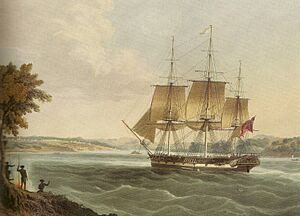
The first plans for the colony were simple. It was meant to be a self-sufficient penal colony based on farming. Trade, shipping, and shipbuilding were banned. This was to keep convicts isolated and not interfere with the British East India Company's trade. There was no plan for economic growth beyond producing raw materials for Britain.
After Governor Phillip left, military officers began buying land and importing goods from visiting ships. Former convicts also farmed land they were given and traded. Farms spread to fertile areas around Paramatta, Windsor, and Camden. By 1803, the colony grew enough grain for itself. Boat building also grew to help with travel and use marine resources. Sealing and whaling became important industries.
The early colony's economy relied heavily on the government. For example, some of the first farms were run by the government. In 1800, most people depended on government food rations. This number dropped by 1806. Some convicts worked for settlers, but they could also find part-time jobs and own property. About 10–15% of convicts worked on public projects like building roads. The rest worked for private employers. In 1831, land grants were stopped, and Crown lands were sold instead.
The colonies needed many imports from England to survive. The official money was the British pound. But the most common trade item was rum. The early economy used bartering (trading goods). Governor Lachlan Macquarie (1810-1821) tried to fix this. He introduced Spanish dollars and started the Bank of New South Wales. Bartering continued until more British money arrived in the late 1820s.
Macquarie also helped the economy grow. He hired a planner for Sydney's street layout. He ordered the building of roads, wharves, churches, and public buildings. He sent explorers out from Sydney. In 1815, a road was completed across the Blue Mountains. This opened up large areas for farming and grazing west of the Great Dividing Range.
Colonists spent much of the early 1800s building infrastructure like railways, bridges, and schools. This helped economic development. During this time, Australian businesses began to do well. For example, the partnership of Berry and Wollstonecraft made huge profits from land grants, convict labor, and exporting cedar to England. John Macarthur started the wool industry in Australia.
From the 1820s, "squatters" increasingly set up cattle and sheep farms without permission. In 1836, a system of annual licenses was introduced to control the pastoral industry. But high wool prices and expensive land encouraged more squatting. By 1844, wool made up half of the colony's exports. By 1850, fewer than 2,000 pastoralists controlled most of eastern New South Wales.
Religion, Education, and Culture
Religion
Before Europeans arrived, Indigenous people practiced their own spiritual beliefs, including The Dreaming. Christianity in Australia began with the First Fleet in 1788. The main Christian church was the Church of England. However, about one-tenth of the convicts were Catholic, mostly from Ireland.
The authorities were suspicious of Catholics because some Irish convicts had been sent for political reasons. The first Catholic ceremony in Australia was held by French explorers in 1788.
In early colonial times, Church of England clergy worked closely with the governors. Richard Johnson, the First Fleet's Anglican chaplain, was told to improve "public morality." He was also involved in health and education. Reverend Samuel Marsden was a magistrate and known for his harsh punishments.
Catholic convicts had to attend Church of England services. Their children were raised Protestant. The first Catholic priests arrived as convicts in 1800. One, James Dixon, was allowed to celebrate Mass. On May 15, 1803, he held the first Catholic Mass in New South Wales.
The Irish-led Castle Hill Rebellion in 1804 worried the British. Dixon's permission to hold Mass was taken away. Later, two more priests were allowed to travel to the colony in 1820. The first St Mary's Cathedral, Sydney began construction in 1821.
The Church Act of 1836 gave equal legal rights to Anglicans, Catholics, and Presbyterians. It was later extended to Methodists. Catholic missionary William Bernard Ullathorne criticized the convict system. Laywoman Caroline Chisolm helped female migrants.
Sydney's first Catholic Bishop, John Bede Polding, asked for nuns to come to the colony. Five Irish Sisters of Charity arrived in 1838. They cared for convict women and worked in schools and hospitals. The Christian Brothers arrived in 1843 to help in schools. The Jesuits were the first religious order of priests to establish houses in South Australia, Victoria, Queensland, and the Northern Territory. They set up schools and missions.
Education
At first, education happened mostly at home. However, Governor Richard Bourke believed education was important for people to take part in politics. Francis Forbes founded Sydney College in 1830. The King's School, Parramatta, Australia's oldest surviving independent school, was founded in 1831. By 1833, there were about ten Catholic schools.
Medicine
Many people who practiced medicine were transported to Australia as convicts. Some were not formally trained. Three doctors were important in developing medical institutions. D'Arcy Wentworth arrived in 1790 and became the colony's Principal Surgeon. He also helped found the Bank of New South Wales. William Redfern arrived as a convict in 1801. He proved his surgical skills and became Australia's first medical graduate. He is called the "father of Australian medicine." William Bland arrived in 1814 as a convict. He was a democrat and helped the poor throughout his political career.
Culture
Australian composers published music during this time. Some Australian folksongs also come from this period.
One of the first important Australian books was by Watkin Tench. He wrote about the settlement of Sydney. In 1819, William Wentworth published the first book written by an Australian. It was called A Statistical, Historical, and Political Description of the Colony of New South Wales. In it, he argued for an elected assembly and for Australia to be settled by free immigrants, not convicts. In 1838, The Guardian: A Tale by an Australian by Anna Maria Bunn was the first Australian novel printed and published in mainland Australia. It was also the first Australian novel written by a woman.
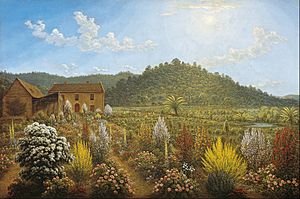
European theatre also came with the First Fleet. The first play was performed by convicts in 1789. The Theatre Royal, Hobart, opened in 1837 and is Australia's oldest theatre. The Melbourne Athenaeum, founded in 1839, was a library and arts school. The Queen's Theatre, Adelaide opened in 1841 and is the oldest theatre on the mainland.
Images for kids
-
Arrival of the First Fleet in Port Jackson in 1788.
-
Acting Lieutenant Charles Robbins raises the Union Jack at King Island, 1802.
-
Charles Fremantle declares Swan River Colony for Great Britain in 1829.
-
The proclamation of government in South Australia, 1836.
-
Captains Hunter, Collins and Johnston with Governor Phillip and Surgeon White visiting an Aboriginal woman near Port Jackson, 1793.
-
A steeple-chase at Five Dock, 1844. Equestrianism was an early organized sport.
-
Parramatta in 1812.
See also
- British colonisation of South Australia
- British colonisation of Tasmania
- European Australian
- Europeans in Oceania
- History of Australia
- History of New South Wales
- History of Queensland
- History of South Australia
- History of Tasmania
- History of Western Australia
- Journals of the First Fleet


